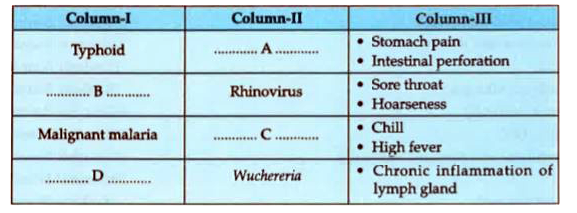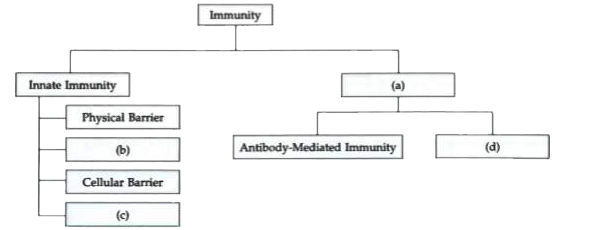Complete Solutions to REVISION EXERCISES (III. SHORT ANSWER TYPE - I QUESTIONS) (A. QUESTIONS FROM STATE BOARD EXAMINATIONS) of chapter HUMAN HEALTH AND DISEASES of Class 12 book with complete answers and questions
| Class 12 | BIOLOGY |
| Chapter | HUMAN HEALTH AND DISEASES |
| MODERN PUBLICATION | REVISION EXERCISES (III. SHORT ANSWER TYPE - I QUESTIONS) (A. QUESTIONS FROM STATE BOARD EXAMINATIONS) |
| Number Of Questions | 79 |
| Academic Year | 2023-24 |
Classify the diseases given below as two groups based on their causative organisms. Specify the type of causative organism for each group. Typhoid, Malaria, Pneumonia, Diphtheria, Amoebiasis.
02:25View SolutionWhat are the primary lymphoid organs?
02:00View SolutionWrite the name of pathogens of typhoid and pneumonia.
02:34View SolutionWhat is passive immunity? Give its two examples.
02:37View SolutionDescribe opioid drugs.
02:14View SolutionHow does transmission of HIV-infection generally occur?
02:28View SolutionWrite about drug cocaine.
01:59View SolutionList the differences between antigen and antibody.
04:57View SolutionExpand the terms: ELISA, NACO and HIV.
02:18View SolutionDifferentiate between innate and acquired immunity.
04:38View SolutionWrite a note on allergy.
02:41View SolutionDifferentiate between normal cell and cancer cell.
02:51View SolutionWhat is cell-mediated immunity.
03:33View SolutionDifferentiate between active and passive immunity.
03:32View SolutionGive two important features of acquired immunity.
02:23View SolutionWhat are effects of alcohol on the liver and kidneys.
04:28View SolutionWrite down symptoms of malaria.
02:25View SolutionHow does transmission of amoebiasis take place?
01:44View SolutionList the differences between antigen and antibody.
04:57View SolutionExpand the terms: ELISA, NACO, HIV.
01:22View SolutionDifferentiate between Innate immunity and Acquired immunity.
02:59View SolutionWrite a note on allergy.
02:18View SolutionWhat do you mean by Ringworm disease?
02:30View SolutionMention the causes of cancer.
03:03View SolutionFrom which plant is opium extracted? Write two medicinal properties of opium.
02:01View SolutionName the causative organism of lock jaw. Write its two symptioms.
01:42View SolutionDefine antigen and antibody.
04:26View Solutiondistinguish between B cells and T cells
04:45View SolutionDifferentiate between Interferons and antibodies.
02:19View SolutionFollowing are the differences between innate immunity and acquired immunity.
Select the option pair of differences.
 02:19View Solution
02:19View SolutionName the intermediate and the final hosts of malarial parasite.
03:50View SolutionDraw a well-labelled diagram of an antibody molecule.
03:38View SolutionWhat is the source of L.S.D. ? What harm does it cause?
01:52View SolutionDifferentiate between benign and malignant tumours.
02:26View SolutionExplain the effect of alcohol on the liver.
02:56View SolutionList any three preventive measures of AIDS disease.
04:12View SolutionDifferentiate between B-cells and T-cells of the immune system. How do the B-cells respond to antigens?
06:04View SolutionWhat are interferons? Name one disease controlled by them.
01:24View SolutionWhat is incubation period?
01:21View SolutionWrite five danger signals of cancer.
02:31View SolutionWhat is meant by auto-immune diseases? Give two example.
02:00View SolutionWhat is auto-immune disease? Give one example.
02:09View SolutionDifferentiate between acquired and innate immunity.
03:48View SolutionWhat is drug abuse? Give an example of a tranquillizer.
04:00View SolutionGive the full name of HIV. What is AIDS?
02:07View SolutionWhat is vaccine? How does it develop immunity in a person?
02:20View SolutionDefine allergy. Give any two symptoms of Allergic reactions.
02:54View SolutionWhat are interferons? How do they help in controlling the disease?
02:41View SolutionWrite four harmful effects caused by alcohol addiction.
02:09View SolutionMorphine is said to be an abused drug. Discriminate the terms 'use' and 'abuse' of drugs based on this example.
03:28View SolutionDifferentiate active immunity from passive immunity. Give an example of passive immunity.
03:11View SolutionName the causal organism of chickenpox. Mention two important symptoms.
01:43View SolutionWhat are the harmful effects of smoking cigarettes?
04:17View SolutionWhat are the pathogens of following diseases?
(a) Amoebiasis (b) AIDS (c) Pneumonia02:45View SolutionWhat are the pathogens of following diseases?
(a) Cholera (b) Rabies (c) Ringworm02:54View SolutionWhat are the pathogens of following diseases?
(a) Pneumonia (b) Measles (c) Elephantiasis02:32View SolutionWhat are interferons? How do they check viruses?
04:12View SolutionDefine vaccine. Who coined the term ?
01:40View Solution"Liver suffers most from excessive drinking". Discuss the statement.
01:47View SolutionWhat is innate immunity? Mention any two types of innate immunity barriers.
02:50View SolutionInnate immunity is a non-specific type of defense and consists of four types of barriers. Categorise the barriers and give one example of each.
05:34View SolutionConsumption of drug and alcohol affects the person's mental and physical health very badly. List the warning signs of alcohol or drug abuse.
05:01View SolutionComplete the table given below:
 03:48View Solution
03:48View SolutionWrite the various components of immune system.
03:33View SolutionVACCINATION AND IMMUNISATION
08:53View SolutionWhen is a tumour referred to as malignant?
02:50View SolutionHow does amoebiasis occur in human beings?
02:29View SolutionName the pathogen of amoebiasis. What are its preventive measures?
02:43View SolutionWhat are interferons? How they act?
01:45View SolutionWrite a short note on vaccines.
03:04View SolutionWhat is the pathogen of ascariasis? How it can be controlled?
02:50View SolutionWhat are hallucinogens? Give an example.
03:01View SolutionWhat is autoimmunity? Name any one autoimmune disease of human beings.
02:02View SolutionWhat is an allergy? Name two chemicals released by the mast cells in the body during allergy.
02:35View SolutionName the primary and secondary lymphoid organs.
01:52View SolutionDescribe in brief the process of transmission of malaria disease.
03:47View SolutionWhat do you mean by metastasis?
02:46View SolutionComplete the flow chart given below:
 05:10View Solution
05:10View SolutionList of some diseases commonly occurring in man are given below. Arrange them in the following table on the basis of causative organism.
Malaria, Common cold, Filariasis, Typhoid, Ascariasis, Ringworm, Amoebiasis, Pneumonia
 03:54View Solution
03:54View Solution
REVISION EXERCISES (III. SHORT ANSWER TYPE - I QUESTIONS) (A. QUESTIONS FROM STATE BOARD EXAMINATIONS) questions and complete solutions for chapter HUMAN HEALTH AND DISEASES of MODERN PUBLISHERS BIOLOGY (HINGLISH) of Class 12
All Exercises from MODERN PUBLICATION Class 12 BIOLOGY HUMAN HEALTH AND DISEASES
- Chapter Practice Test
- Chapter Practice Test (Section - A)
- Chapter Practice Test (Section - B)
- Chapter Practice Test (Section - C)
- Chapter Practice Test (Section - D)
- COMPETITION FILE (OBJECTIVE TYPE QUESTIONS)(A. MULTIPLE CHOICE QUESTIONS)
- COMPETITION FILE (OBJECTIVE TYPE QUESTIONS)(B. MATCHING TYPE QUESTIONS: )
- COMPETITION FILE (OBJECTIVE TYPE QUESTIONS)(C. ASSERTION - REASON TYPE QUESTIONS: )
- Higher Order Thinking Skills & Brain Twisting (Long Answer Questions)
- Higher Order Thinking Skills & Brain Twisting (Short Answer Questions)
- Higher Order Thinking Skills & Brain Twisting (Very Short Answer Questions)
- NCERT Exemplar Problems (A. MULTIPLE CHOICE QUESTIONS)
- NCERT Exemplar Problems (B. VERY SHORT ANSWER TYPE QUESTIONS)
- NCERT Exemplar Problems (C. SHORT ANSWER TYPE QUESTIONS)
- NCERT Exemplar Problems (D. LONG ANSWER TYPE QUESTIONS)
- NCERT FILE SOLVED (NCERT Exercise Questions)
- PRACTICE PROBLEMS - ALCOHOLISM
- PRACTICE PROBLEMS - CANCER BIOLOGY
- PRACTICE PROBLEMS - COMMON DISEASES OF MAN
- PRACTICE PROBLEMS - DRUG ADDICTION
- PRACTICE PROBLEMS - HUMAN GEALTH AND DISEASES
- PRACTICE PROBLEMS - IMMUNE DISORDERS
- PRACTICE PROBLEMS - IMMUNE SYSTEM
- PRACTICE PROBLEMS - TOBACCO ADDICTION
- QUICK MEMORY TEST (A. Say True or False)
- QUICK MEMORY TEST (B. Complete the missing links)
- QUICK MEMORY TEST (C. Choose the correct alternative)
- REVISION EXERCISES (I. MULTIPLE CHOICE QUESTIONS (MCQs)
- REVISION EXERCISES (II. VERY SHORT ANSWER QUESTIONS) (A. QUESTIONS FROM STATE BOARD EXAMINATIONS)
- REVISION EXERCISES (II. VERY SHORT ANSWER QUESTIONS) (B. QUESTIONS FROM CBSE EXAMINATIONS)
- REVISION EXERCISES (III. SHORT ANSWER TYPE - I QUESTIONS) (A. QUESTIONS FROM STATE BOARD EXAMINATIONS)
- REVISION EXERCISES (III. SHORT ANSWER TYPE - I QUESTIONS) (B. QUESTIONS FROM CBSE EXAMINATIONS)
- REVISION EXERCISES (IV. SHORT ANSWER TYPE - II QUESTIONS) (A. QUESTIONS FROM STATE BOARD EXAMINATIONS)
- REVISION EXERCISES (IV. SHORT ANSWER TYPE - II QUESTIONS) (B. QUESTIONS FROM CBSE EXAMINATIONS)
- REVISION EXERCISES (V. CASE - BASED SHORT ANSWER QUESTIONS)
- REVISION EXERCISES (VI. LONG ANSWER TYPE QUESTIONS)(A. QUESTIONS FROM STATE BOARD EXAMINATIONS)
- REVISION EXERCISES (VI. LONG ANSWER TYPE QUESTIONS)(B. QUESTIONS FROM CBSE EXAMINATIONS)
